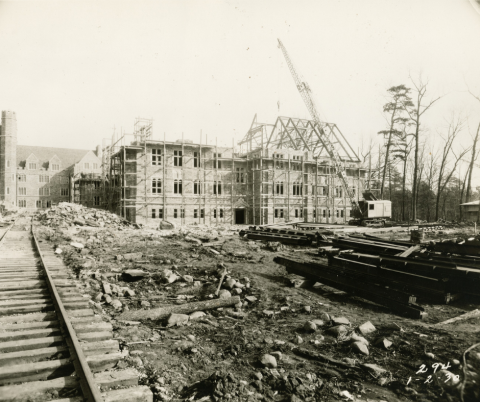World Building at Duke in an Emerging Durham: 1924-1932 (2023-2024)
The establishment of the Duke Endowment in 1924 enabled the massive building campaign that gave us the Duke University we know today. That building history has been researched in its essential parts. However, two aspects remain under-investigated: how the building process itself developed from a series of plans that included competing concepts of landscape, social organization and place; and how that building process intersected with and impacted local individuals, communities and institutions.
This team examined how Durham and Duke's built and natural environments were shaped by and contributed to the development of social, economic and political conditions during Duke’s planning and construction. The team combined historical research, geospatial analysis and 3D modeling to explore several topics, including Duke's natural and built environments; relationships between Duke and Durham; Durham's cultural and physical expansions; and the projection of the university and the city's images nationally and globally.
Learn more about this team's work by reading their team profile.
Timing
Fall 2023 – Summer 2024
Team Outputs
Team website
Digital and physical exhibition at Duke Libraries (opening January 2025)
Mapping and Modeling Duke and Durham (Team profile; 2024 Fortin Foundation Bass Connections Virtual Showcase)
World Building at Duke in an Emerging Durham: 1924-1932 (Interactive display presented at Fortin Foundation Bass Connections Showcase, April 17, 2024)
ArcGIS StoryMaps
3-D models of Duke’s campus and building plans
This Team in the News
Digital Humanities on the Rise
Blueberrying and More: Expanding the History of Bennett Place
New Bass Connections Project: World Building at Duke in an Emerging Durham
New Project Teams Will Delve Into Duke’s History to Mark the Centennial
Image: West Campus Progress Picture #294, 1930, licensed under CC BY-NC-SA 4.0

Team Leaders
- Robert Buerglener, Arts & Sciences-Information Science and Information Studies
- Hannah Jacobs, Arts & Sciences-Art, Art History, and Visual Studies
- Victoria Szabo, Arts & Sciences-Art, Art History, and Visual Studies
- Ed Triplett, Arts & Sciences-Art, Art History, and Visual Studies
/graduate Team Members
-
Savannah Fitzpatrick, Digital Art Hist/Comp Media-AM
-
Wendy Vencel, History-PHD
-
Veda Kanduri, Master of Engineering Mgmt-MEG
-
Ruojin Shi, Digital Art Hist/Comp Media-AM
-
Bryan Rusch, Art and Art History-PHD
-
Kalei Porter, Liberal Studies-AM
/undergraduate Team Members
-
Ruth Player, Civil Engineering (BSE), Art History (AB2)
-
Malynda Wollert, Art History (AB)
-
Nathaniel Waxman, Art History (AB)
-
Jiayi Wang
-
Madison Wall
-
Isabel Shew
-
Katherine Newbold, Mathematics (BS), Statistical Science (BS2)
-
Elaijah Lapay, Program II (AB)
-
Hailey Kasney
-
Brooke Hira, Art History/Visual Arts (AB)
-
Carmen Chavez, Economics (BS)
-
Annapurna Bhattacharya
/yfaculty/staff Team Members
-
Trudi Abel, Duke Libraries
-
Philip Stern, Arts & Sciences-History
-
Paul Jaskot, Arts & Sciences-Art, Art History, and Visual Studies
-
Carson Holloway, Duke Libraries
